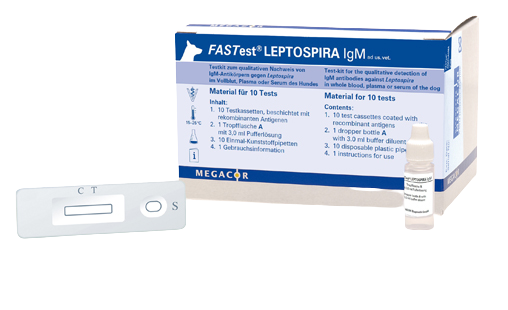Description
Qualitative detection of IgM antibodies against Leptospira spp.
Test Applicable to: Dogs
Sample: plasma, whole blood supernatant and serum
Leptospirosis (Weil’s disease)
Is a world-wide spread bacterial infectious disease in various animals and humans (zoonosis). Of the pathogen species Leptospira interrogans sensu lato, more than 300 serovars are known which are summarised in 24 serogroups of varying pathogenicity. Due to non-existence of a cross immunity of the vaccination serovars and an increasing “serovar shift”, leptospirosis becomes more important (world-wide increasing prevalences especially for L. icterohaemorrhagia, L. canicola, L. grippotyphosa, L. australis and L. pomona).
Transmission
Transmission can be direct: horizontal (esp. infectious abortion material, urine, food animals [pathogen reservoir: rodents, small mammals], bites, veneric), vertical (lactogenic, placental) and indirect: contaminated soil, water.
Incubation time & Symptoms
Incubation time as well as symptoms are strongly dependant on age, immune status, serovar type. Subclinical infections are usually (higher seroprevalence than the prevalence of the clinical disease), proven by numerous studies. With present immunity due to past infection, normally quick antibody (ab) formation and pathogen elimination takes place. Typically, general symptoms like fever, apathy, anorexia, lethargy, loss of weight, diarrhoea 3–7 days after infection as well as pale icteric mucous membranes. Other symptoms are late abortion, still births, birth of weak young animals. Within 48–72 h, a severe, potentially fatal illness can develop, depending on organ manifestation (especially kidneys [tubular persistence], liver and lung [haemorrhagic syndrome] dysfunctions, DIC).
Diagnosis
Clinically suspected leptospirosis requires a quick, laboratory-ensured diagnosis, because the animals become a shedder and infection risk for humans and animals. Because the direct proof of the pathogen (dark field microscopy, culture, PCR [false negative through high antibiotic dose]) often is difficult, time consuming, expensive and only proves if positive, the ab detection, especially the IgM detection, has an important diagnostic relevance.
The actual reference method is microagglutination test (MAT). However, its sensitivity varies strongly (30–80%) depending on the stadium of infection, and it does not distinguish between IgM and/or IgG antibodies. Therefore, a straight IgM detection (increase in the 1st week p. inf. / maximum from week 2–3 on), can be of significant diagnostic benefit compared to MAT or straight IgG detection (detectable not until 3–4 weeks, persistence for months, vaccination-caused IgG antibody persistence).
The FASTest® LEPTOSPIRA IgM is an important diagnostic tool for the veterinarian for the fast and simple on-site detection of a leptospirosis in the early stage of infection. Therefore, further laboratory diagnostics as well as therapeutic and prophylactic measures can be started immediately.
FASTest LEPTOSPIRA Product Information


